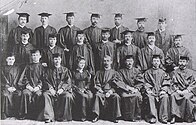Philip Jaisohn
He declined, choosing to focus on reform movements where he advocated for democracy, Korean independence and self reliance from foreign intervention, numerous civil rights and universal suffrage.Thereafter he was appointed to Gyoseokwan Bujeongja (교서관 부정자; 校書館 副正字) and Seungmunwon Gajuseo (승문원 가주서; 承文院假主書).In 1883 he was appointed to Seungmunwon Bujeongja (승문원 부정자; 承文院 副正字) and Hunryunwon Bubongsa (훈련원 부봉사; 訓鍊院 副奉事).By that time, a small but growing number of young intellectuals believed that fundamental reform had to occur or Korea would fall victim to the neighboring imperialist powers of Qing China, Japan, or Russia.In December 1884, Jaisohn, following Kim Ok-gyun, was involved in the Gapsin Coup, a radical attempt to overturn the old regime and establish equality among people.Jaisohn and Kim Ok-gyun, Park Yeong-hyo, Yun Chi-ho, Hong Yeong-shik, and others had planned a coup for seven months, from July to December 1884.In 1886, Jaisohn lived in Norristown, Pennsylvania, and attended the Harry Hillman Academy (Wilkes-Barre, PA) thanks to the help of John Welles Hollenback.[6] He promoted national independence as the principal political ideal and emphasized neutral diplomatic approaches to protect Korea from China, Russia and Japan.Under the aegis of the Independence Club (독립협회; 獨立協會), Jaisohn organized the All People's Congress, an open public forum to debate over political issues.When he heard the news of the March 1st Movement (1919), a nationwide protest against Japanese rule in Korea, Jaisohn convened the First Korean Congress, which was held in Philadelphia for three days on April 14–16, 1919.Floyd W. Tomkins, rector of the Episcopal Church of the Holy Trinity, Philadelphia on Rittenhouse Square and established the "Korean Information Bureau."In the 1920s, Jaisohn, who had just turned 60, returned to research and spent his 60s and 70s working as a specialist doctor and micro-biologist, as well as occasionally publishing in peer-review academic journals.[6] Five years later in 1924, Jaisohn went legally bankrupt due to his political engagement and had to resume practicing medicine to make a living.When the date of the first presidential election was confirmed by the United Nations, Jaisohn was petitioned to run for presidency by 3,000 people, including a young Kim Dae-jung, but he refused in the end.Suffering a heart attack a week earlier on December 29, Jaisohn died on January 5, 1951, during the Korean War, just two days before his 87th birthday.





Korean nameBoseongJeollaJoseonNorristown, PennsylvaniaUnited StatesSeoul National CemeterySouth KoreaHangulRevised RomanizationMcCune–ReischauerArt nameCourtesy nameLiberalism in South KoreaClassicalConservativeDonghakSocialChristianityChristian leftDemocratizationDue processEconomic freedomEconomic progressivismEnvironmentalismFreedom of the pressFreedom of religionFreedom of speechIndependence movementKorean nationalismPacifismReunificationSunshine PolicyLegal egalitarianismLiberal democracyMixed economyRepublicanismRule of lawWelfare stateDemocracy movements2016–2017 protestsGwangjuMinjung-GayoDonghak Peasant RevolutionKorean independence movementAhn Chang HoChang Chun-haChang MyonCho Bong-amCho KukChough Pyung-okHan Myeong-sookIm Jong-seokJang Hye-youngKim Dae-jungKim Han-gilKim Je-dongKim Jee-woonKim Kyu-sikKim Ou-joonKim Seong-suKim Young-samKo Min-jungKwon In-sookLee Jae-myungJasmine Bacurnay LeeLee Nak-yonLee Sang-donNa Hye-sokMa Kwang-sooMoon Jae-inPark Ji-hyunPark Jie-wonPark Jong-chulPark Won-soonPark Yong-jinRoh Moo-hyunRhyu Si-minRyu Ho-jeongShin Hae-chulSim Sang-jungSong Jin-wooSong Kang-hoSin Ik-huiYoun Kun-youngYun Po-sunCreative Korea PartyDemocratic Alliance of KoreaDemocratic Korea PartyDemocratic Nationalist PartyDemocratic Party of KoreaFuture Democratic PartyGrand Unified Democratic New PartyKorea Democratic PartyMinsaeng PartyNational Congress for New PoliticsNew Democratic PartyNew Future PartyNew Korean Democratic PartyNew Politics Alliance for DemocracyOpen Democratic PartyParticipation PartyParty for Democracy and PeacePeace Democratic PartyPlatform PartyReal Democratic PartyRebuilding Korea PartyReunification Democratic PartyUri PartyBareunmirae PartyBasic Income PartyNew Political Vision PartyDawn of Liberty PartyGaehwa PartyIndependence ClubKorean EmpireJustice PartyNational Independence FederationNew Korea PartyPine Tree PartyKorean Provisional GovernmentImperial Japanese occupationTransition KoreaDong-a IlboHankook IlboHankyoreh
